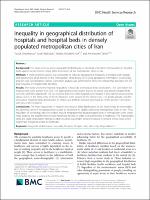| dc.contributor.author | Chavehpour, Yousef | |
| dc.contributor.author | Rashidian, Arash | |
| dc.contributor.author | Woldemichael, Abraha | |
| dc.contributor.author | Takian, Amirhossein | |
| dc.date.accessioned | 2021-12-03T07:21:57Z | |
| dc.date.available | 2021-12-03T07:21:57Z | |
| dc.date.issued | 2019-12 | |
| dc.identifier.issn | 1472-6963 | |
| dc.identifier.uri | https://resources.equityinitiative.org/handle/ei/292 | |
| dc.description.abstract | Background: This study aims to assess geographical distribution of hospitals and extent of inequalities in hospital beds against socioeconomic status (SES) of residents of five metropolitan cities in Iran. Methods: A cross-sectional analysis was conducted to measure geographical inequality in hospital and hospital bed distributions of 68 districts in five metropolitan cities during 2016 using geographic information system (GIS), and Gini and Concentration indices. Correlation analysis was performed to show the relationship between the SES and inequality in hospital beds densities. Results: The study uncovered marked inequalities in hospitals and hospital beds distributions. The Gini indices for hospital beds were greater than 0.55. The aggregated concentration indices for public and private hospital beds were 0.33 and 0.49, respectively. The GIS revealed that 216 (70.6%) hospitals were located in two highest socioeconomic status classes in the cities. Only 29 (9.5%) hospitals were located in the lowest class. The public, private, and the cumulative hospitals beds distributions in Tehran and Esfahan showed significant (p < 0.05) positive correlation with SES of the residents. Conclusions: The high inequalities in hospital and hospital beds distributions in our study imply an overlooked but growing concern for geographical access to healthcare in rapidly urbanizing metropolitan cities in Iran. Thus, regardless of ownership, decision-makers should emphasize the disadvantaged areas in metropolitan cities when need arises for the establishment of new healthcare facilities in order to ensure fairness in healthcare. The metropolitan cities and rapid urbanization settings in other countries could learn lessons to reduce or prevent similar issues which might have hampered access to healthcare. | |
| dc.format.extent | 8 p. | |
| dc.language.iso | en | |
| dc.publisher | BMC Health Serv Res | |
| dc.rights | © The Author(s). 2019 Open Access | |
| dc.subject | Geographical distribution | |
| dc.subject | Inequality | |
| dc.subject | Hospital | |
| dc.subject | Regionalization | |
| dc.subject | Main cities | |
| dc.title | Inequality in geographical distribution of hospitals and hospital beds in densely populated metropolitan cities of Iran | |
| mods.genre | journalArticle | |
| schema.audience | Fellows | |
| dc.identifier.doi | 10.1186/s12913-019-4443-0 | |

